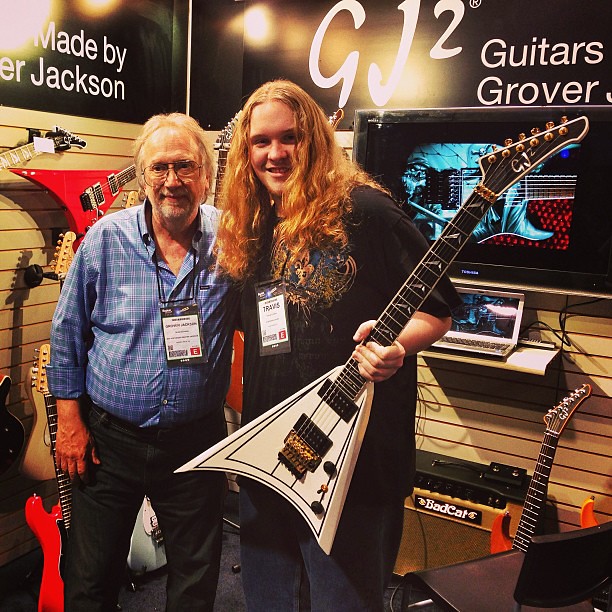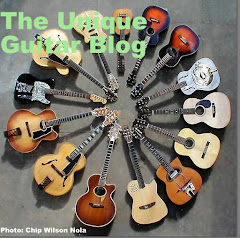Randy Rhoads is another on the list of the most influential rock guitars that ever lived. And yet he is another guitarist that, tragically, left us when he was way too young.
| Randy and his Mom's school |
Randy began taking classical guitar lessons there at age 7.
He soon became interested in the electric guitar and took lessons from his mother's friend, Scott Shelly, right up to the point where Scott told her that he could no longer teach Randy since Randy had become a much better player than he would ever hope to be.
| Kelle & Kelly Garni & Rhoads |
They spent their summers playing at high school parties and local shows doing covers of songs by Mountain, Alice Cooper, the Rolling Stones and David Bowie songs.
Rhoads and Garni had an "ah-hah" moment at an Alice Cooper show when the realized what could be done with their talent.
Rhoads was a bright kid. He began teaching guitar at his mother's school and playing gigs at night. He was also able to continue school and was fast-tracked to graduate.
In 1972 Rhoads and his friend Kelly Garni recruited singer Kevin Dubrow and drummer Drew Forsyth and put together what would become one of the first neo-classical metal groups known as Quiet Riot.
At the time Rhoads was playing a cream coloured 1972 Gibson Les Paul Custom that his band mates had purchased for his use. Rhoads was only 16 years old! This became the guitar that he used throughout his career.
This guitar was a unique instrument as the body was actually made of four pieces including two layers of mahogany with a thin layer of maple in the middle and a carved maple top.
When it was new it was white, but over time the paint oxidized and took on a cream patina. Rhoads made a few changes to the guitar by replacing the original brass switch-plate and adding Grover tuning machines.
During most of the ‘70’s Rhoads played guitar with Riot, but he also played in another band called Xciter which featured guitarist George Lynch. Both men were interested in guitar techniques and equipment.
| George Lynch & Karl Sandoval |
 |
| Wayne Charvel |
This was due to the fact that Danelectro necks were almost flat. The fretboard radius of a Danelectro was 14". This was at a time, when most Gibsons had a 12" radius and some Fenders had a 7.25 - 9" radius.
 |
| Sandoval with unfinished V |
Since Rhoads wanted a Fender tremolo bridge with a sustain block, this guitar had to be thicker than most V shaped guitars.
To mount the Danelectro neck to the body, Sandoval came up with an extension of the neck that would be underneath the neck pocket to support the Dano neck. The extension and the neck were glued and clamped into place.
The next problem would be the Gibson pickups that Rhoads insisted should be on the guitar. Rhoads also wanted the Fender Strat-style tremolo. The problem was Fender’s string spacing was wider than Gibson pole pieces. The solution was to use a DiMarzio Super Distortion pickup in the bridge position and a PAF in the neck position. The wiring on these pickups was similar to Gibson and allowed for two volume and two tone controls.
Randy Rhoads other request for his guitar would be to have a harpoon-shaped headstock. Sandoval accomplished this by using the existing Danelectro headstock and using dowels on its sides to graft on pieces of wood then cutting them to produce the harpoon shape. The resulting V shaped guitar had a 25.5” scale and a neck radius of 17” and a very unique headstock.
Within three weeks of receiving the Sandoval V, Rhoads had broken the guitar. During a show, the strap came loose, the guitar crashed to the floor and the neck broke. He felt bad, but took it back to Karl Sandoval who repaired it for $75. Randy Rhoads to the guitar to England and soon after left Quiet Riot to play in Ozzy Osborne’s new band.
By Christmas time of 1980 Randy Rhoads had come up with an idea for a new guitar. Wayne Charvel had just sold his business to Grover Jackson. Karl Sandoval was moving away from luthiery and developing his own business. And Randy Rhoads had an idea burning in his mind for a new guitar. He sought out Grover Jackson for guidance.
 |
| Grover Jackson |
 |
| The first Concorde |
There was no question in Grover Jackson’s mind that this request was do-able. But at the time, Jackson was concerned about the look of the guitar and how his new company would be represented.
| 1970's Charvel |
Jackson just spent a lot of money to acquire Charvel and he was not going to do anything to hurt the business.
 |
| Grover Jackson |
So Grover Jackson called Rhoads and asked if he would mind putting a different name on this guitar.
To his surprise Rhoads said that would be alright. Rhoads had always admired the Gibson Explorer and wondered if an Explorer head could be modernized and made to look more aggressive. Grover Jackson went to work on building the guitar shortly after the holidays. Randy Rhoads returned to England.
The body was cut using the technology of the day, which consisted mostly of pin routers. Charvel at the time was building B.C. Rich guitars and applied the beveled edges to the Rhoads instrument.
Once a prototype was built on a piece of Baltic birch, it was time for the real build. This was done with a maple center block that was glued to two maple wings. It was a heavy instrument. The neck joined the body at the 14th fret. There were 22 frets on a compound radius ebony fretboard. This fretboard was shaped by hand to achieve a 12” radius at the necks bottom, which tapered off to a 16” radius.
The fret wire was very narrow. The neck featured pearl block inlay and binding. The nut was 1 11/16th inches. This guitar had a tremolo, but it was not made by Fender, it was handcrafted by the company’s metal smith Bill Gerein.
Rhoads sent word to Grover Jackson that he would like to build a second guitar. His aim was for the new model to be narrower and slightly more radical. In the fall of 1981 Randy and Grover got together again. Grover was prepared with three neck-thru-body sections with headstock already cut. The wings were separate. As if they were working on a puzzle, the men moved the wings here and there; sanded off some wood, and drew on the wood until they got it right.
By the time the tour had reached the United States, Ozzy’s tour manager Sharon Arden (now Sharon Osbourne) had upped the ante by investing in full stage production. The rehearsals were being held at studios in Hollywood before the opening night in San Francisco. Jackson had the second Concorde guitar completed. This time the shorter, lower wing made the upper wing more pronounced.
Look carefully at the guitars back side. Rhoads covered it with black electrical tape. This was during the Diary of a Madman tour so when he walked out on stage in the darkness he would have the back facing the audience. That way the white guitar did not spoil the big "lights on" moment.
It was odd that Randy was somewhat hesitant about fully embracing the new guitar. He would play it through portions of the show, then put it down and play a different guitar. He seemed to be warming up to it. We will never know if Randy Rhoads would have put away his other guitars and played this new model exclusively. For two months later he was killed in a plane crash.
Karl Sandoval maintained his business known as Sandoval Engineering. He is still building guitars and teaching luthiery. He currently offers the 30th Anniversary Sandoval V; the guitar based on the original design he built for Randy Rhoads.
In 1996 he joined RIC Rickenbacker Guitars helping them to develop use of the CNC routers. About a year later he went on to work at some other firms including G&L, Tacoma and Sadowsky guitars. In 2010 he worked on that years models for B.C. Rich. The late Bernie Rico was one of his friends.
Since 2012 he is building and selling his own brand known as GJ² Guitars.
©UniqueGuitar Publications (text only)
\
















No comments:
Post a Comment